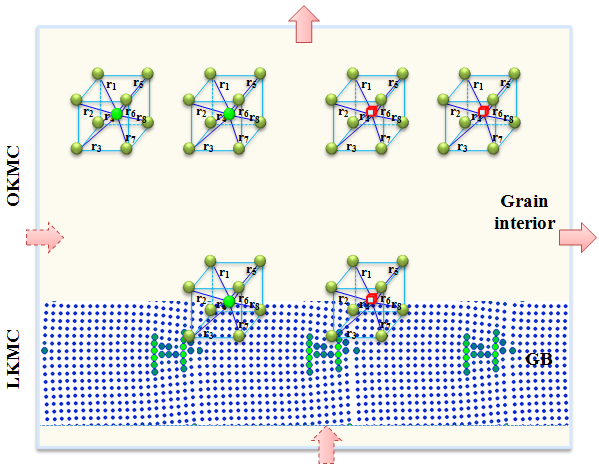Research
Radiation Damage Simulation Software Developed for Defect Accumulation Mechanisms Study in Polycrystalline Materials
| By
Recently, the research group led by Prof. LIU Changsong from Institute of Solid State Physics (ISSP), Hefei Institutes of Physical Science (HFIPS) of Chinese Academy of Sciences (CAS) developed a set of software for simulating the evolution of displacement damage in polycrystalline metals at across time and space scales, which was named object kinetic Monte Carlo-lattice kinetic Monte Carlo (OKMC-LKMC) hybridization simulation software.
Using this software, research team explored the accumulation and evolution of vacancies at iron (Fe) grain boundaries (GBs).
The results were published in Journal of Nuclear Materials.
Polycrystalline/Nanocrystalline (PC/NC) Fe was found to exhibit improved radiation resistance.In previous multiscale simulations, GBs were often abstracted as two-dimensional planes without specific structures, and a series of energetic and kinetic parameters were used to characterize the structural characteristics of GBs. However, the diversity of GB character makes GBs exhibit distinct local structures and defect properties. If these properties are simply abstracted as a single interaction parameter, a lot of atomic information related to defects would be missed, thereby affecting the accurate prediction of defect evolution on a long time scale.
The technology developed in this research can not only distinguish the spatial position dependence of defect properties at GBs, but also simulate the evolution of defects away from the GB region in a coarse-grained manner.
Researchers investigated the accumulation mechanisms of Vs at Fe GBs, mainly focused on the interaction processes of Vs with different GBs.
The results clarified the dependence of Vs accumulation on the GB character. At high temperature, the atomic processes of V emission and leakage were discovered in addition to the well-known trapping of the V by the GB. The occurrence of these processes depends on the GB character. Based on the combination of grain size, V formation energy at the GB and migration energy barrier within the GB, the coupling equation of grain size with GB character was proposed.
When this equation is satisfied, the defect emission process that originally occurred in the high energy level region is inhibited by the defect cruise along the GB. This brings about the uncertainty on the relation of the radiation performance to the defect–GB binding strength particularly in the case of a small grain size.
This work reveals new V-GB interaction processes, as well as the coupling between these processes. These results have general significance for other PC systems, which can shed light on the radiation response of PC materials, and provide a mechanism reference for experimentally optimizing the radiation resistance of materials based on GB engineering.
This work was supported by the National Key Research and Development Program of China, the National Natural Science Foundation of China and Foundation of President of Hefei Institutes of Physical Science, Chinese Academy of Sciences.

Illustration of the method for OKMC-LKMC hybridization simulation. (Image by LI Xiaolin)

Several V motion trajectories near the GBs drawn from LKMC simulation. The horizontal line indicates the GB position. (Image by LI Xiaolin)

- Attachments Download:
-
contact
Prof. LIU Changsong
E-mail: csliu@issp.ac.cn


